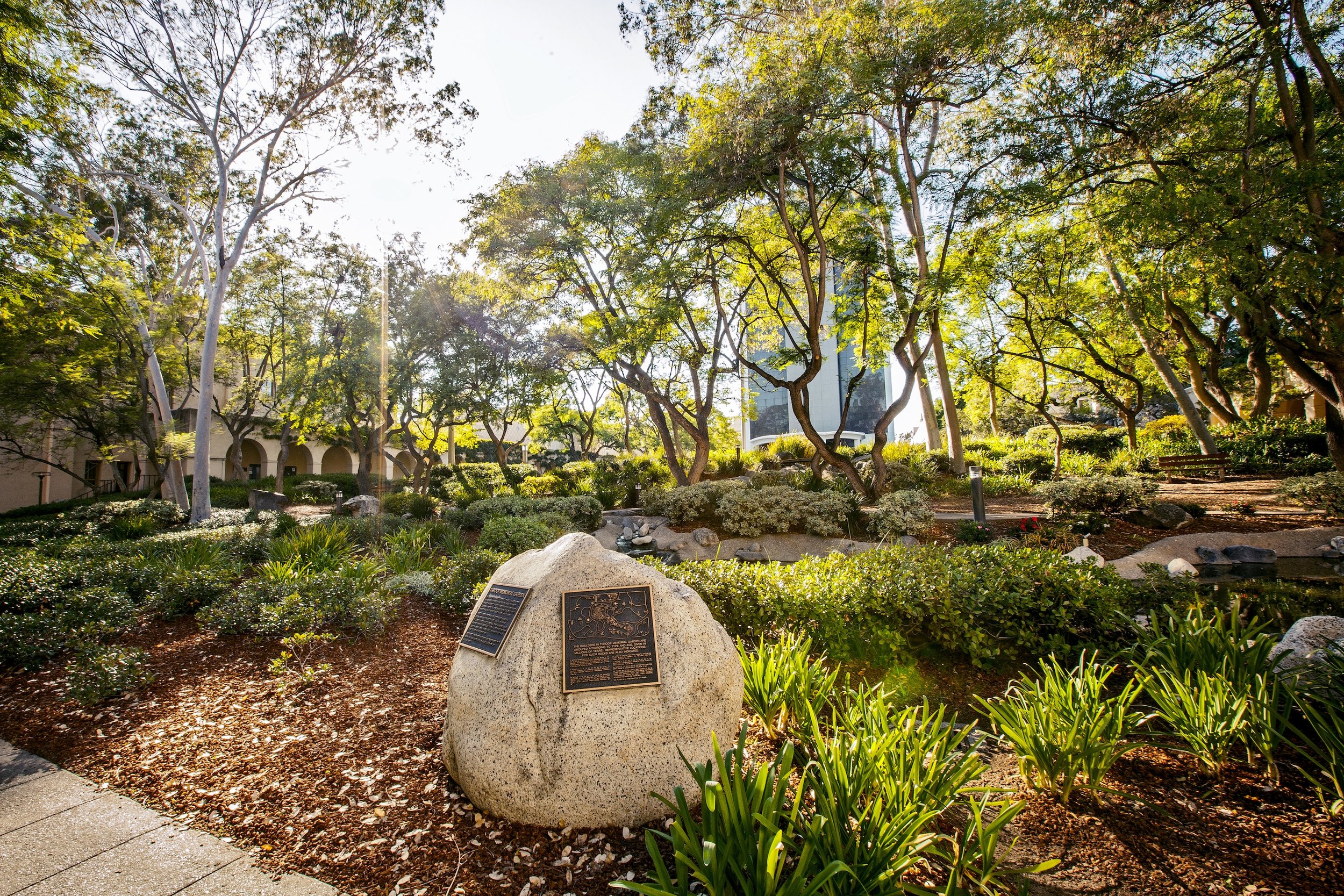Memories of Throop
Long before ducks made their nests among turtles and squirrels in what is now known as Throop Memorial Garden, the very first building on the Caltech campus called that space home. Where there are now ponds stood the pillars of what was called Pasadena Hall, built in the early 20th century. The building held up by those pillars was renamed Throop Hall in 1920—the same year the Throop College of Technology became the California Institute of Technology—to honor the school’s founder, Amos G. Throop. When the building opened in 1910—jam-packed with classrooms, laboratories, and administrative offices—it was said to be earthquake proof. The 6.6 San Fernando temblor of 1971 seemed to disprove that notion, leaving behind deep cracks in the facade of the great hall. Engineers, lacking the original construction plans and thus unable to know if the building was likely to be savable, recommended demolition. When a wrecking ball started to smash away at the concrete exterior, however, it revealed large amounts of steel rebar. The building, it turned out, likely could have stood for many more years.
But that was not to be. In 1973 Throop Hall came down, and it was soon replaced by the lush gardens seen on the site today.
However, physical reminders of this historic heart of the campus still remain . . . if you know where to look.
Calder Arches
One of the defining features of Throop Hall was the archway above its main entrance, a Beaux Arts–inspired sculpture by Alexander Stirling Calder, father of the artist of the same name who is known for creating large-scale artistic mobiles. Inspired by themes in the inaugural address by Caltech’s first president, James Scherer, the elder Calder created allegorical figures to represent Scherer’s vision of the Institute. According to the book Caltech’s Architectural Heritage, by Romy Wyllie, the archway was considered to be one of the most important sculptural projects in Los Angeles at the time.
For over 60 years, the figures on the arches—representing Nature, Art, Energy, Science, Imagination, and Law—watched over the campus and served as the backdrop for celebrations and class photographs.
Despite the ’71 quake and the decision to tear down Throop Hall, the sculptures were saved; at the last moment, they were carefully cut from the building. For 13 years they sat in a Pasadena city yard, the victims of government plans to place them at city hall that never came to fruition. Then, in the mid ’80s, Caltech pulled the forlorn figures out of the dirt and weeds, and gave them a place of honor on the second-story bridge spanning the (at the time) newly renovated Church and Crellin buildings, which together composed the Arnold and Mabel Beckman Laboratory of Chemical Synthesis.
It is on that expanse that most of the carefully restored archway can be found today. Although the arches are nearly identical to how they appeared on Throop Hall, the bridge corrects a curious mistake made in the original sculpture: two of the bottom plaques had been placed incorrectly, with the mask of Art appearing under the column showing Science, while the hammer and anvil hung below the depiction of Art. They now appear in their originally intended positions.
In addition, two of the pilasters, or columns—along with their plaques— were sacrificed, unable to be crammed onto the bridge. They can be found in the courtyard between the buildings and behind the Beckman bridge, where they seem to be guarding the not-so-secret passageway between Crellin and the Kerckhoff Laboratories. Standing among a collection of trees, one represents “the emblem of the Law,” while the other—decorated with sunflowers—is meant to represent Nature. Their concrete plaques flank the northern entrance of the passageway and depict life, death, and eternity (on the plaque that hung below the sunflower column on the original building) and a hand on an open book (on the plaque embodying of the concept of Law).
Throop Clock
In the early 1940s—long before Throop Hall’s demise—a clock was added to its facade, high above Calder’s arch. It endured years of pranks, including a 1965 prank in which students turned its face into a Mickey Mouse watch, with the Disney character’s arms keeping time. It was also saved from Throop Hall’s fate and, a few years after the hall’s demise, was renovated by undergrads from Ricketts House and remounted on the northeast corner of the Kellogg Radiation Laboratory.
It can still be found there today, quietly ticking away in the shade provided by the trees in Throop Memorial Garden.
Apollo Statue
When Throop Hall first opened, one of its inaugural visitors was Apollo Belvedere—or, rather, an exact copy of the classical sculpture of that name, whose original can be seen at the Vatican Museum. Apollo stood on a staircase in the entryway, guarding the hall for 30 years, a gift to one of the hall’s architects, Elmer Gray, who decided to display sculpture in his newest achievement. When the staircase was remodeled in the 1940s, Apollo was moved to a balcony that connected Throop to Kellogg Lab. The balcony was a victim of the Throop demolition, but Apollo escaped, spending some time in the Dabney gardens, among other places, and eventually making his way to the Braun Athletic Center, where he still resides today, perhaps to serve as inspiration for those toiling away on stationary bicycles or heading out to the track. He is a Greek god, after all.
To learn more about Throop Hall and its peripatetic pilasters and statues, check out: Caltech’s Architectural Heritage: From Spanish Tile to Modern Stone by Romy Wyllie (Balcony Press, 2000), Raised Arches, or, You Can Go Home Again, E&S (May 1986), Caltech’s Throop Hall by Judith R. Goodstein, and Alice Stone (California Institute of Technology, 1981)
—Katie Neith
Header photo: HC Van Urfalian



